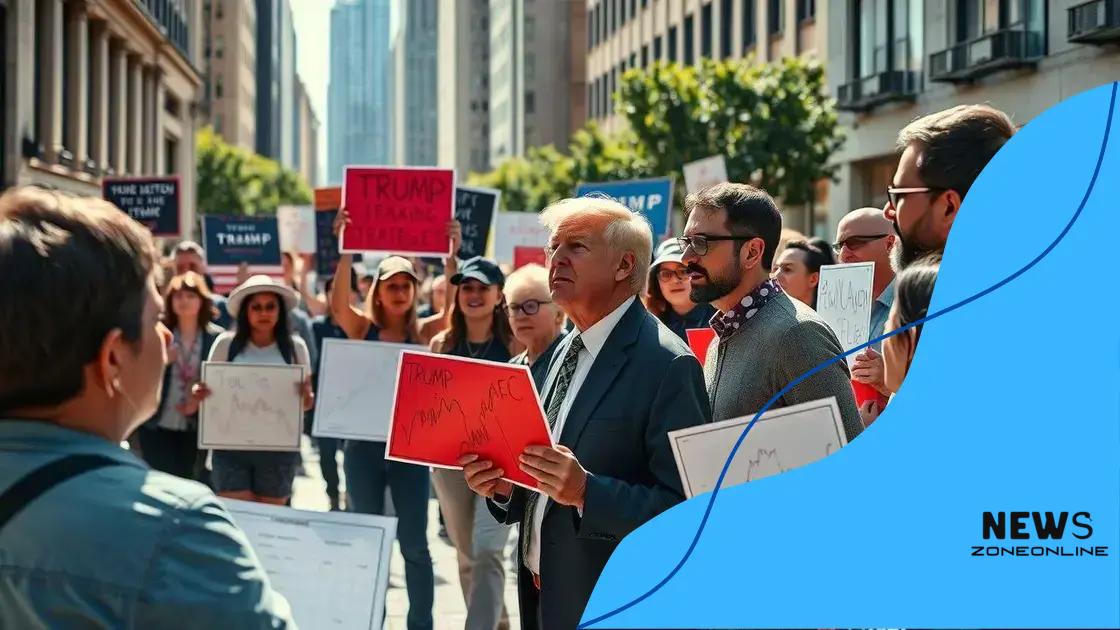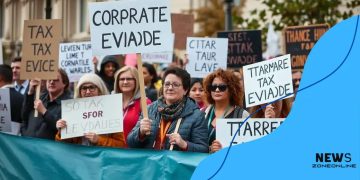Trump-era economic strategy: what really happened

The Trump-era economic strategy focused on tax cuts, deregulation, and trade protectionism, leading to significant economic growth but also raising concerns about income inequality and long-term sustainability.
The Trump-era economic strategy reshaped numerous aspects of American finance. But what does this mean for us today? Let’s dive into the policies and their lasting effects.
Understanding the core principles of the Trump-era economic strategy
Understanding the core principles of the Trump-era economic strategy involves exploring several key ideas that influenced policies during this time. This strategy was largely based on the idea of promoting American industry and boosting domestic production.
Key Principles
One of the main principles was the focus on tax cuts. By reducing taxes for both individuals and businesses, the aim was to stimulate economic growth. This strategy was intended to encourage spending and investment among consumers and companies alike.
Another important aspect was the emphasis on trade protectionism. The administration sought to renegotiate trade deals to favor American workers. This approach involved tariffs on certain imports to protect local industries.
Additional Factors
- Deregulation aimed to lessen the burden on businesses, allowing for more entrepreneurial freedom.
- The focus on infrastructure investment was meant to modernize America’s roads and bridges, creating jobs and improving productivity.
- Energy independence policies promoted the use of domestic fossil fuels and renewable energy investments.
Throughout the Trump presidency, these core principles shaped discussions in Congress and among the public. They prompted both enthusiasm and criticism, revealing the complex impacts of such economic strategies. The focus on these principles was not without controversy, leading various analysts to debate their long-term effects.
In examining how these core principles played out, it’s crucial to consider how they influenced job markets, consumer behavior, and national debt. Economic indicators during this time provided mixed signals, showcasing both growth and challenges.
Key achievements during the Trump administration
Key achievements during the Trump administration were significant in shaping the economic landscape of the United States. This period saw a mix of policy changes that brought various outcomes.
Tax Reform
The Tax Cuts and Jobs Act of 2017 was one of the hallmark pieces of legislation. This law reduced the corporate tax rate from 35% to 21%, which aimed to encourage investment and boost economic growth. This reform was touted as a way to increase wages and stimulate hiring.
Job Growth
Another noted achievement was the increase in job growth before the COVID-19 pandemic. Unemployment rates reached historic lows, dropping to under 4%, and many industries saw significant gains. The administration focused on deregulation, which helped businesses thrive and expand.
- Massive investments in infrastructure enhancement projects that aimed to modernize transportation.
- Focus on manufacturing jobs returning to the U.S., which aimed to revitalize the industry.
- Initiatives promoting energy independence, reducing reliance on foreign oil.
The economy also benefitted from trade renegotiation efforts. For instance, the United States-Mexico-Canada Agreement (USMCA) replaced NAFTA, aiming to strengthen labor and environmental standards across North America. These negotiation strategies were viewed as crucial to securing better terms for American workers.
During this time, the stock market experienced significant growth, with major indices reaching record highs. This reflected investor confidence in the administration’s policies and their impact on economic performance. However, it is essential to note that these achievements came with substantial debate and criticism from various sectors.
Critiques and controversies surrounding economic policies

Critiques and controversies surrounding economic policies during the Trump administration sparked significant debate among economists, politicians, and the public. Many viewed these policies as polarizing and often detrimental to certain sectors of the economy.
Tax Cuts and Their Impact
While the tax cuts were designed to spur growth, critics argued that they disproportionately benefited the wealthy. This led to concerns about increasing income inequality. Some reports suggested that while corporations enjoyed tax breaks, many workers saw minimal improvement in wages, questioning the effectiveness of this strategy.
Trade Wars
The trade wars initiated by imposing tariffs on imports were another major point of contention. While supporters claimed these moves aimed to protect American jobs, detractors pointed out that these tariffs often resulted in increased prices for consumers. Many industries faced retaliatory tariffs from other countries, leading to job losses in sectors such as agriculture.
- The impact on manufacturing jobs raised alarm as companies faced higher costs and shifted production overseas.
- Concerns over agricultural exports surfaced as farmers struggled with declining sales due to international tensions.
- The impact of economic isolationism became a contentious point for future trade relations.
Moreover, the focus on deregulation sparked debates about the long-term effects on the environment and public health. Environmentalists criticized policies that rolled back protections, claiming these actions could lead to lasting damage. There were also worries about the impact of deregulation on financial markets, as some believed it could lead to a lack of oversight and increased risk.
Despite these critiques, the administration maintained that the policies were effective in boosting economic confidence and growth. This ongoing debate reflected the broader struggles in American economic policy, highlighting the complexities and differing opinions surrounding these decisions.
Long-term impacts on the American economy
The long-term impacts on the American economy due to the policies enacted during the Trump administration continue to unfold. Many analysts argue that these changes have created a mixed landscape of opportunities and challenges.
Economic Growth Trends
One of the primary impacts is the initial spike in economic growth rates. The policies focused on tax cuts and deregulation aimed to energize the market. Although there was notable growth in GDP prior to the pandemic, questions remain about sustainability.
Job Market Dynamics
The job market experienced fluctuations, with significant job creation in certain sectors. However, this growth was uneven across industries. While manufacturing jobs showed signs of revival, service sectors and technology roles faced a different reality. The growth in gig economy positions became more apparent as traditional job structures evolved.
- Increased reliance on gig work and contract positions altered job security for many workers.
- Wage growth remained stagnant for some, raising concerns over income inequality.
- Many laid-off workers faced challenges in retraining for new industries.
Another crucial aspect was the shift in global trade relationships. Ongoing trade disputes altered America’s ties with key partners, impacting import and export dynamics. While some companies benefited from protective tariffs, others struggled with price increases and disrupted supply chains. These changes created ripples throughout the economy, affecting consumer choices and inflation rates.
Moreover, the focus on energy policy and deregulation sparked debates over environmental sustainability. The move towards fossil fuels raised long-term concerns regarding climate change and natural resource management. The ongoing transition towards renewable energy sources has become a focal point in discussions about economic resilience.
What we can learn from the Trump-era economic choices
What we can learn from the Trump-era economic choices offers important insights into economic policymaking. The decisions made during this time provide valuable lessons for future administrations and policymakers.
Understanding Economic Outcomes
Firstly, it’s essential to assess the effectiveness of tax cuts. While these cuts aimed to spur growth, the mixed results highlight the need for careful analysis. This situation underscores the importance of addressing income inequality, as benefits were not evenly distributed.
The Role of Trade Policies
Another critical lesson involves the impact of trade policies. The trade wars and tariffs demonstrated the potential risks of protectionism. While these strategies aimed to protect American jobs, they also led to increased costs for consumers and retaliatory measures from other countries. Understanding this balance is vital for developing future trade agreements.
- Consider how international relations can shape economic conditions.
- Analyze the long-term effects on domestic industries and job markets.
- Evaluate the successes and failures of negotiation strategies.
The focus on deregulation during the Trump years raises additional lessons regarding environmental and financial protections. While deregulation may promote short-term growth, it also poses risks to the public and the environment. Monitoring these outcomes offers a path to balancing economic growth with sustainability.
Furthermore, the shifts in job dynamics, such as the rise of gig work, prompt discussions around future labor markets. Fostering job security and retraining programs could provide robust answers to these changing job landscapes. Looking ahead, preparing for emerging job trends will be crucial as the economy continues to evolve.
FAQ – Frequently Asked Questions about Trump-era Economic Strategy
What were the key components of the Trump-era economic strategy?
The key components included significant tax cuts, deregulation, and renegotiation of trade agreements aimed at boosting American manufacturing.
How did tax cuts impact the economy during Trump’s presidency?
Tax cuts aimed to stimulate economic growth but raised concerns about increasing income inequality as benefits were not evenly distributed.
What lessons can we learn from the trade policies implemented?
Trade policies showed that protectionism can lead to higher consumer prices and strained international relations, emphasizing the need for balanced trade agreements.
What long-term effects did deregulation have on the American economy?
Deregulation spurred short-term growth but also led to concerns over environmental sustainability and financial stability, showcasing the need for careful oversight.





